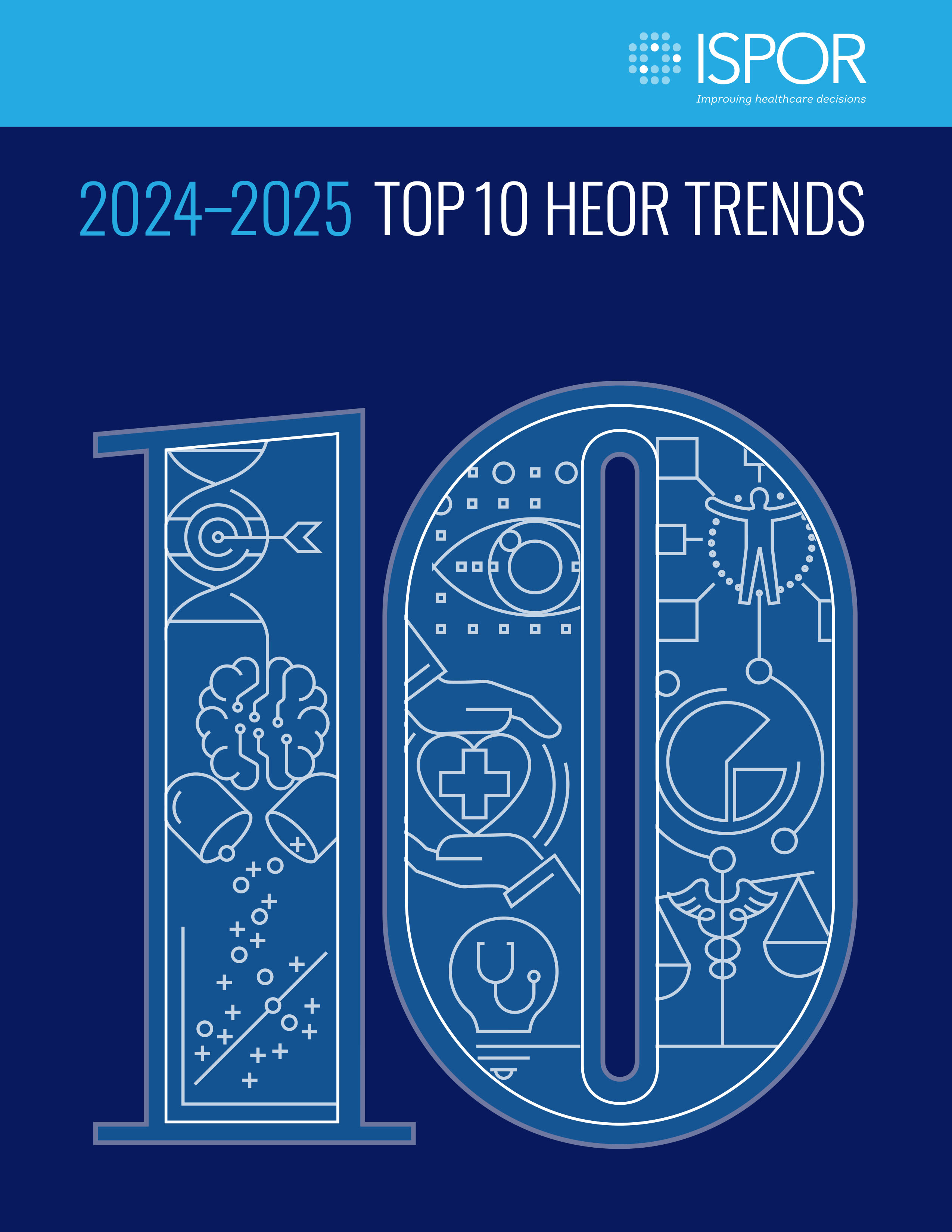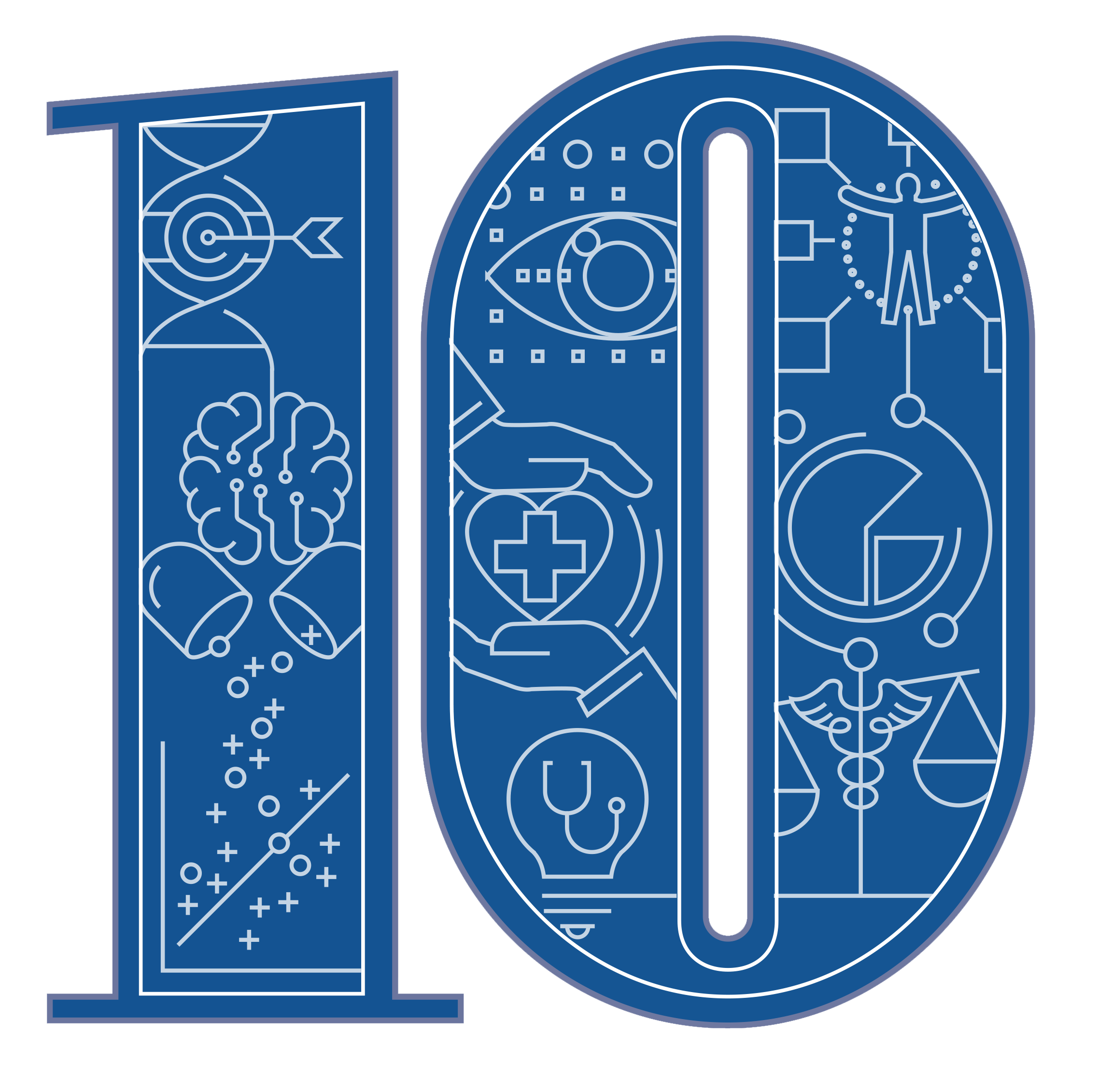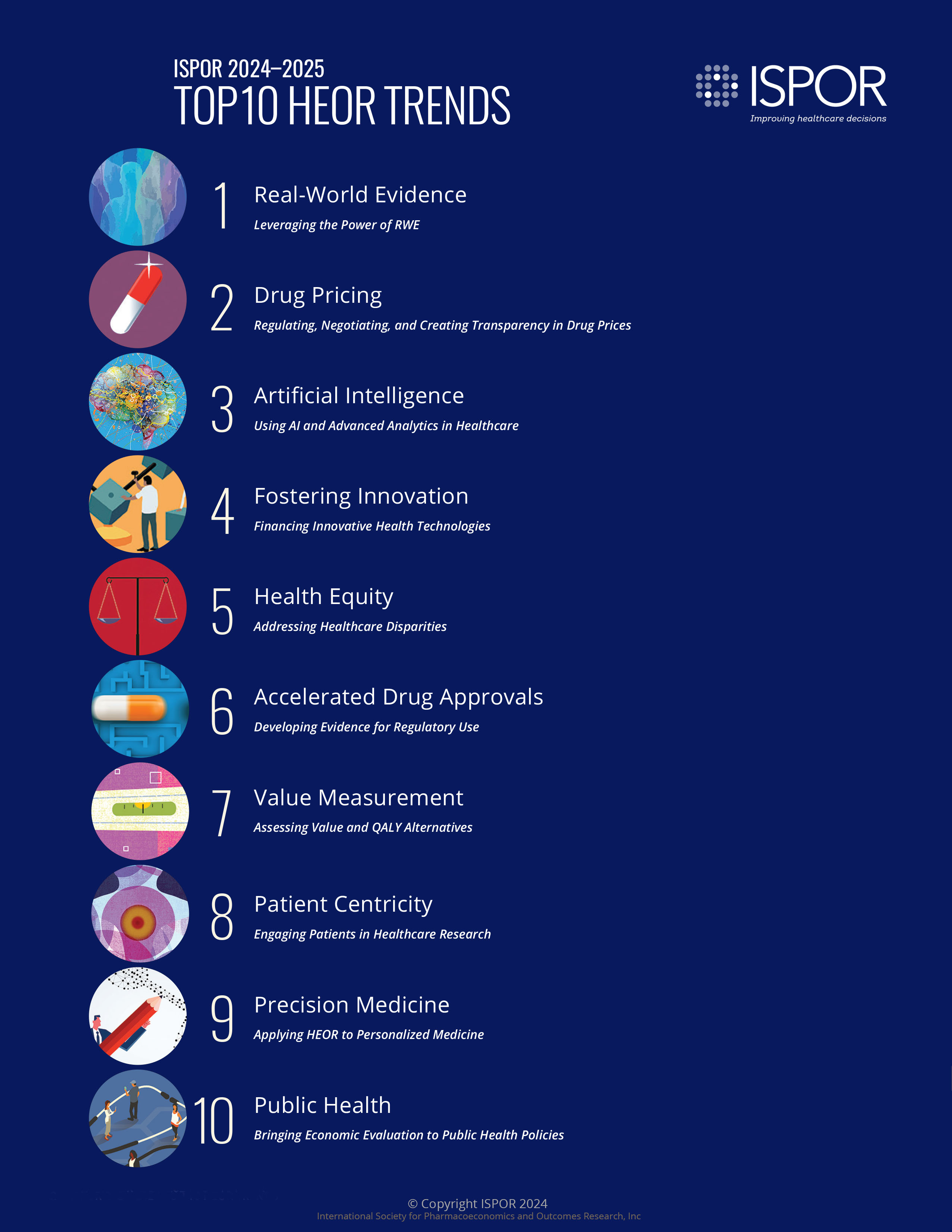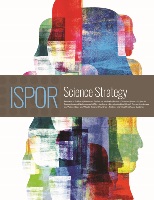ISPOR 2024-2025 Top 10 HEOR Trends Report
 ISPOR—The Professional Society for Health Economics and Outcomes Research (HEOR) continues to monitor healthcare trends and conduct horizon scanning around the world.
ISPOR—The Professional Society for Health Economics and Outcomes Research (HEOR) continues to monitor healthcare trends and conduct horizon scanning around the world.
The “ISPOR 2024-2025 Top 10 HEOR Trends” marks the fifth publication of the Society’s biennial report, which is based on input from its members and strategic curation from its Health Science Policy Council.
A summary of the ISPOR 2024-2025 Top 10 HEOR Trends and the full report are both available below. This report is the fifth publication for this initiative that is now published as a biennial report.
2024-2025 Top 10 HEOR Trends
Executive Summary...
ISPOR—The Professional Society for Health Economics and Outcomes Research (HEOR) continues to monitor healthcare trends and conduct horizon scanning around the world. The “ISPOR 2024-2025 Top 10 HEOR Trends” marks the fifth publication of the Society’s biennial report, which is based on input from its members and strategic curation from its Health Science Policy Council.
Real-world evidence (RWE) appears again as the #1 trend in this report. RWE has made the trends list for 4 of 5 reports and has appeared as #1 in the 3 most recent reports. The use of RWE in healthcare decision making is becoming ever more tangible and is increasingly used to augment randomized controlled trials.
Drug pricing is also a recurring theme, appearing as #2 in this report. Drug pricing has appeared in some form in each of the past trends reports. In the United States, the Inflation Reduction Act (IRA) brings a systemic change by introducing drug price negotiations for Medicare. While the IRA directly impacts the United States, it may also impact the rest of the world since US drug profits have historically funded much of the innovation in new drug development.
Artificial intelligence (AI) returns to the trends list as the #3 trend in this report. AI has entered the public conversation in a pronounced way as many people are becoming comfortable with ChatGPT as a tool in their daily lives. AI and machine learning are also employed in HEOR in a variety of ways to gain valuable insights.
A new topic for this report and appearing as the #4 trend—fostering innovation—focuses on the balance of incentivizing the development of innovative, new technologies with affordable pricing. Health equity returns as the #5 trend, having first appeared in the previous report. Accelerated drug approvals returns to the trends list as #6, having first appeared in the inaugural 2018 report. Value measurement appears as #7 in this report and has appeared in some form in the past 3 trends reports. Patient centricity comes in as #8 in this report. Precision medicine returns to the trends list as #9, having previously appeared in the 2019 and 2020 reports. And public health is the #10 trend after first appearing in the 2022-2023 report during the pandemic.
The field of HEOR continues to grow in importance as healthcare systems throughout the globe face increasing pressures. HEOR provides invaluable data to core healthcare stakeholders—including researchers and academicians, assessors and regulators, payers and policy makers, the life sciences industry, healthcare providers, and patients—to help inform and improve healthcare decisions for all. ISPOR’s members will continue their vital work on these and other HEOR-related topics towards fulfilling the Society’s mission to improve healthcare decisions for patients around the world.
#1 Real-World Evidence...

Real-World Evidence: Leveraging the Power of RWE
Coming in at #1 once more as a top 10 trend, real-world evidence (RWE) has become “real,” as it starts to play a very tangible role in healthcare decision making. Research using RWE provides many benefits that cannot be derived from randomized controlled trials (RCTs) alone.
RWE studies can present a more realistic view of patients and health outcomes in practice by offering insights into real people in the real world. RWE is more inclusive as it comprises data from a wide and diverse group of patients. Additionally, RWE studies can be conducted much more quickly than RCTs, providing another realistic option for generating evidence to answer questions about the safety and effectiveness of products.
As RWE continues to gain significant traction in healthcare, agencies including the United States Food and Drug Administration (FDA), the European Medicines Agency (EMA), The National Institute for Health and Care Excellence (NICE), and Canada’s Drug and Health Technology Agency (CADTH) have recently released guidance on different aspects of RWE generation and use. Key topics have been data quality, fit-for-purpose use, registries, and external control arms. Other important areas of focus for RWE have been methods and conditions supporting reliable causal inference as well as use of RWE as part of the “totality of evidence” supporting a new product or indication, and reporting of study process and results. In 2023, the EMA published a report of its studies using RWE, as EMA and the European medicines regulatory network work to establish a sustainable framework to enable the use of RWE and prove the value of RWE across different regulatory use cases.1
One example of how RWE has been used in regulatory scenarios also marks the first time RWE was used in the United States as primary evidence of efficacy. In 2021, RWE was used for a new indication of tacrolimus for prevention of organ rejection in lung transplants, relying on data from a noninterventional (observational) treatment arm, where tacrolimus was used off-label, compared to historical controls, with both arms drawn from the Scientific Registry of Transplant Recipients.2
RWE is a key strategic initiative for ISPOR. In polling its members on RWE, the Society found that particular topics of interest were transparency of study processes; improved capture of outcomes; analysis methods such as causal inference; data quality definitions; and defining what makes data “fit for purpose.”
Much of ISPOR’s work in RWE has focused on the important area of transparency in RWE studies, ISPOR has published “Good Practices for Real-World Data Studies of Treatment and/or Comparative Effectiveness.”3 In partnership with the International Society for Pharmacoepidemiology (ISPE), the Duke-Margolis Center for Health Policy, and the National Pharmaceutical Council, ISPOR conducts the Real-World Evidence Transparency Initiative. Through this Initiative, a report was published in Value in Health that encourages routine registration of noninterventional RWE studies used to evaluate treatment effects, and the Real-World Evidence Registry was launched to promote a culture of transparent reporting for RWE studies on treatment effects.
The Society organized an ISPOR Summit on RWE in 2023, held in collaboration with ISPE and the Duke-Margolis Center for Health Policy. A summary of the Summit outcomes can be found in the Value & Outcomes Spotlight article, “Real-World Evidence: From Frameworks to Practice.”
#2 Drug Pricing...

Drug Pricing: Regulating, Negotiating, and Creating Transparency in Drug Prices
Drug pricing continues to be a global issue in healthcare, and concern over the impact of high prices continues to grow, pushing this trend from #6 in the previous report to #2 in the 2024-2025 report.
Discussion has been driven by policies such as the Inflation Reduction Act (IRA) in the United States, under which the US Medicare program will be entering negotiations with manufacturers over the prices of 10 high-expenditure drugs, as well as the European Union pharmaceutical strategy, which is proposing several ways to improve access and affordability.4,5
Higher prices and high demand for novel therapies put pressure on national healthcare systems to ensure access while still maintaining budgets. One example of this is the demand for the weight-loss drug Wegovy (semaglutide), which some researchers say could significantly impact healthcare spending in the United States. The cost of Wegovy already has private and government insurers balking at coverage.6
The IRA introduces a seismic change in the United States, marking the first time the government will be engaging in drug price negotiations. Initially, the prices of 10 drugs—Eliquis (apixaban), Jardiance (empagliflozin), Xarelto (rivaroxaban), Januvia (sitagliptin), Farxiga (dapagliflozin), Entresto (sacubitril/valsartan), Enbrel (etanercept), Imbruvica (ibrutinib), Stelara (ustekinumab), and Fiasp/NovoLog (insulin aspart)—will be negotiated for Medicare purposes 8 to 10 years into their marketing period, before their patent expiration would normally create generic competition, with 10 to 15 more drugs to undergo price negotiation each year until 2030.7 In Europe, the Joint Clinical Assessment (EU-JCA) is a strategy that will launch in 2025 to evaluate oncology therapies and new advanced therapy medicinal products (ATMPs) and, by 2030, will be used to evaluate all centrally approved medicines for reimbursement. A number of experts believe that the EU-JCA will have a beneficial impact on patients’ access to medicines, especially in countries with lower relative healthcare budgets.
The ultimate effects of both pieces of legislation are yet to be seen. While the IRA directly impacts the United States, it will also impact the rest of the world since drug profits in the United States have historically funded much of the innovation in new drug development. According to the Pharmaceutical Research and Manufacturers of America (PhRMA), the drug industry lobbying group in the United States, economists are predicting investments in research and development (R&D) will shrink, along with the number of small-molecule drugs reaching the market, and there will be less R&D on existing medicines after they are approved.8 In addition to the EU-JCA, the European Commission’s draft pharmaceutical legislation has provisions that would affect numerous aspects of how pharmaceuticals are regulated in Europe, including reducing intellectual property protection from 8 to 6 years.9 While it proposes that intellectual property protection could be extended if new drugs reach country markets quickly, a study in the Journal of Comparative Effectiveness Research theorizes that unless the lag between marketing authorization and reimbursement tightens up, “it may be extremely challenging for manufacturers to negotiate reimbursement across the EU [European Union] within the timeframe proposed by the European Commission.”10
This is an issue that ISPOR and the global health economics and outcomes research (HEOR) community will be following closely and is a prominent topic in the Society’s conferences, summits, journals, and educational offerings.
#3 Artificial Intelligence...

Artificial Intelligence: Using AI and Advanced Analytics in Healthcare
Rising to #3 in the 2024-2025 report from #10 in the previous report is the use and impact of artificial intelligence (AI). On everyone’s mind is the impact of OpenAI’s ChatGPT, which has made many people comfortable with using AI as a tool in their daily lives.
ChatGPT leads the wave in large language models (LLMs), which are a type of software tool involving artificial neural networks trained using self-supervised learning and semi-supervised learning from information scraped from the Web. These LLMs can be used as a writing support—for example, helping clinicians write their practice notes—but also can be used to summarize large amounts of clinical data.
In health economics, these machine learning (ML) algorithms can be employed to look at data in various ways that can help researchers and payers better understand the safety and effectiveness of treatment. ML algorithms could also be used to build physician diagnostic tools, act as a quality check on human work (such as physicians’ assessments on radiology exams), or build apps that can be used to self-manage conditions (such as for low back pain or schizophrenia).11,12
For health economics and outcomes research (HEOR), ML algorithms can organize and structure complicated or high-volume data in ways that can yield insights for improving healthcare decisions. ML is also being used to perform literature reviews, write statistical code, and develop models.
ISPOR’s Good Practices Report on machine learning identified 5 methodological areas where ML could enhance HEOR: (1) Cohort selection, identifying samples with greater specificity with respect to inclusion criteria; (2) Identification of independent predictors and covariates of health outcomes; (3) Predictive analytics of health outcomes, including those that are high-cost or life-threatening; (4) Causal interference through methods, such as targeted maximum likelihood estimation or double debiased estimation, helping to produce reliable evidence more quickly; (5) Application of ML to the development of economic models to reduce structural, parameter, and sampling uncertainty in cost-effectiveness analysis.13
At the ISPOR 2023 annual international conference, the Signal Series session, “Larger, Deeper, and in Real Time: Applications of Machine Learning and Natural Language Processing on Electronic Health Records to Learn From the Patient Journey at Scale,” featured 3 case studies and sought to describe the pragmatic impact of applying ML and natural language processing to electronic health records to generate and accelerate insights.14 Audience polling conducted during the session found many of those who attended would prefer that the AI they use be assistive (helping patients make decisions and acting as a second set of eyes for clinicians and researchers) rather than autonomous (AI making clinical treatment decisions that impact patient care and outcomes). The conference itself had AI as one of its main themes.15 In addition to the Signal session, other AI-focused sessions included the second plenary, “AI Wants to Chat With You: Accept or Ignore?” and the third plenary, “Issues and Solutions When Estimating Treatment Effects Using US Electronic Health Record Data.”
#4 Fostering Innovation...

Fostering Innovation: Financing Innovative Health Technologies
A new topic for the 2024-2025 report, the ability to foster innovation, is vital for bringing new health technologies to the market and patients in need. However, the balance of affordable pricing and incentivizing innovation continues to be an ongoing conversation.
Innovation is needed because significant unmet needs exist in many disease states. Medical breakthroughs can bring important new drugs to patients with unmet needs, but they often carry hefty price tags. One example is the gene therapy, Hemgenix (etranacogene dezaparvovec-drlb), approved in 2022 in the United States for the treatment of hemophilia B, which has a list price of $3.5 million.16,17 Additionally, new therapies that impact a wide swath of the population can help many patients, but also have a disruptive impact on payers’ budgets. Leqembi (lecanemab-irmb), given traditional approval by the United States Food and Drug Administration (FDA) in 2023 for mild-to-moderate Alzheimer’s disease, is estimated to cost taxpayers $82,500 per patient per year, on average,18,19 for genetic tests and frequent brain scans, safety monitoring, and other care, according to the Institute for Clinical and Economic Review (ICER).
Additionally, some areas of medicine desperately require innovation, but are not getting the necessary attention due to lack of financial incentives for drug development. A prime example of this is the search for new treatments for drug-resistant bacteria, fungi, and other pathogens. The World Health Organization published a global research agenda for antimicrobial resistance in human health in 2023, identifying 40 research topics for evidence generation to inform policy by 2030.20
In broad ways, the government can help foster innovation in drug development. In 2022, US President Joe Biden issued the “Executive Order on Advancing Biotechnology and Biomanufacturing Innovation for a Sustainable, Safe, and Secure American Bioeconomy” to invest in foundational scientific capabilities, such as genetic engineering technologies and techniques, and to bolster and coordinate federal investment in key research and development areas of biotechnology and biomanufacturing to help further societal goals.21 In 2022, US Representatives Mike Levin (D-CA) and John Joyce (R-PA) introduced the bipartisan Drug Manufacturing Innovation Act 22 to foster innovation in drug manufacturing by building on the FDA’s Emerging Technology Program.23
ISPOR has addressed the need for fostering innovation through its conferences and other events. “New Insights Into ATMP Valuation and Outcomes-Based Pricing Experience” looked at how the Danish healthcare system approached advanced therapy medicinal products (ATMPs) valuation and developed an innovative outcomes-based pricing agreement between pharma and payers.24 “Venture Capital Investment: Upstream Decision Making on Value in Healthcare” explored how venture capital identifies innovation and value.25 And “Beyond Cost-Effectiveness: Defining and Mapping Out Innovation at NICE”26 examined the UK’s National Institute for Health and Care Excellence (NICE) creation of its 5-year strategy for 2021 to 2026, which is intended to help the life sciences industry seeking market access for their technologies, provide guideline recommendations for healthcare providers and commissioners that incorporate up-to-date evidence and data, and give patients improved access to healthcare technologies as well as new ways of engaging and using patient and public opinion to inform the evidence base for guidance development.
#5 Health Equity...

Health Equity: Addressing Healthcare Disparities
Returning to the trends report is health equity, which was also included in the 2022-2023 report. The World Health Organization defines health equity as the absence of unfair, avoidable, or remediable differences among groups of people and highlights that health equity is achieved when everyone can attain their full potential for health and well-being.27 This can be viewed at the population, subpopulation, and individual levels.
Health equity has become an increasingly important topic in health economics and outcomes research (HEOR) and in broader healthcare research. The American Hospital Association notes that disparities in health contribute to lower life expectancies (as much as 25 years between neighborhoods in some US cities) and higher rates of preventable conditions such as diabetes, some cancers, and obesity in rural areas.28
According to the National Institutes of Health’s (NIH) National Institute on Minority Health and Health Disparities, integrating health equity in research and clinical practice means applying frameworks that center on fairness, opportunity, quality, and social justice to promote well-being and health.29 Beyond seeking decreases in health disparities, health equity needs to measure the attainment of aspirational goals to achieve the best possible health for all populations. There are recent methods in health economic evaluation that help identify the equity effects of new treatments, such as distributional cost-effectiveness analysis.30
These measuring methods continue to spark debates, such as when limited health dollars should be spent on new treatments that improve equity versus those that could provide larger overall gains in health, or how equity should be measured, whether across race, gender, income level, unmet need, or some other dimension.
Application of social determinants of health (SDoH) to HEOR is increasing. The World Health Organization defines SDoH as the nonmedical factors that influence health outcomes, such as the conditions in which people are born, grow, work, live, and age, and the wider set of forces and systems shaping the conditions of daily life, including economic policies and systems, development agendas, social norms, social policies, and political systems.31 These factors, both positive and negative, can include income and social protection, education, unemployment and job insecurity, working life conditions, food insecurity, housing, and access to affordable health services of decent quality.
The US Department of Health and Human Services’ (HHS) Office of Disease Prevention and Health Promotion looks at SDoH as part of its Healthy People 2030 initiative.32 HHS sorts SDoH into 5 domains: economic stability, education access and quality, healthcare access and quality, neighborhood and built environment, and social and community context.33
#6 Accelerated Drug Approvals...

Accelerated Drug Approvals: Developing Evidence for Regulatory Use
Accelerated drug approvals returns as a trend after making its appearance in the 2018 trends report. There is tremendous pressure to bring innovative new therapies to market as soon as possible. Much of this pressure is due to the significant unmet need in rare diseases where often no viable treatments currently exist.
Many new drugs coming to market fit into this accelerated approval category. In 2022, 24 of the 37 Center for Drug Evaluation and Research’s novel drug approvals, or 65%, used one or more expedited programs, such as Fast Track, Breakthrough Therapy, Priority Review, or Accelerated Approval.34 One of many drugs approved recently in the United States under the the Food and Drug Administration’s (FDA) accelerated approval process is Krazati (adagrasib) for adult patients with metastatic non-small cell lung cancer.35
In the European Union, of the 89 medicines approved by the European Medicines Agency in 2022, 5 were under accelerated assessment, 9 received conditional marketing authorizations, and 5 received approvals under extraordinary circumstances.36
To speed up the process, these accelerated approvals tend to be based on limited clinical evidence, such as shorter-term trials, or surrogate markers as an indication of treatment activity. For example, the FDA’s surrogate endpoint table includes reduction in amyloid beta plaques as a surrogate endpoint for accelerated approval of Alzheimer’s disease drugs; percent change in anti-FXa activity, from baseline to nadir, for anticoagulant reversal; and pathological complete response for solid tumors.37
Some therapies have good early surrogate marker results that may or may not result in better long-term outcomes. Health economics and outcomes research (HEOR) can play a critical role in filling in the evidence gaps for these accelerated-approval therapies in ways such as obtaining supportive evidence from real-world data to supplement clinical trial data. This can be particularly critical as drug makers are often not conducting, or are slow to conduct, confirmatory studies. After analyzing 30 years of FDA and National Institutes of Health data, National Public Radio reported in 2022 that 42% of currently outstanding confirmatory studies, or 50 of them, either took more than a year to begin following accelerated approval or had not started at all.38 Additionally, 19 of those required studies had not started 3 years or more after accelerated approval, and 4 of them had not started more than 10 years later.
This necessary limited clinical evidence for accelerated approvals results in a “value story” with a lot of uncertainty due to the limited evidence. In some cases, subsequent HEOR research can validate surrogate markers with clinical outcomes data and bring greater confidence to the use of these markers as indicators of efficacy. This could be done by following people taking the treatment after the trials and using methods that estimate causal effects, which can help confirm that the health intervention is actually responsible for the outcome. HEOR validation of surrogate markers can also provide parameters for outcomes-based agreements that allow for coverage of treatments with uncertain effectiveness.
Although not to the same extent, accelerated approvals can also be an issue for medical devices and digital health apps. While these approvals typically require less evidence as part of the regulatory process, HEOR can be applied to augment the evidence there as well.
#7 Value Measurement...

Value Measurement: Assessing Value and QALY Alternatives
Measuring and assessing value is a vital topic, especially as many health systems move toward value-driven care. The quality-adjusted life-year (QALY) is a common measure used in healthcare that assesses the length and quality of life. Although the QALY is used by many health technology assessment agencies, it has also been criticized as undervaluing quality of life for people with chronic conditions, people with disabilities, and older people.
This measure has encountered pushback in the United States with the US Inflation Reduction Act (IRA) that explicitly prohibits the use of QALYs in drug price negotiations, stating “the secretary shall not use evidence from comparative clinical effectiveness research in a manner that treats extending the life of an elderly, disabled, or terminally ill individual as of lower value than extending the life of an individual who is younger, non-disabled, or not terminally ill.” According to the Brookings Institute, “The IRA’s codified prohibition against using QALYs was included to express Congressional intent that all patients’ lives matter equally and should be weighted equally in value determinations.”39
There have been several efforts to address these issues with the QALY. The ISPOR Value Flower includes other important aspects of value such as severity of disease, equity, and value of hope, as well as other individual and societal considerations.40 The Generalized Risk-Adjusted Cost-Effectiveness (GRACE) approach incorporates risk aversion in people’s preferences, uncertainty in treatment outcomes, and many of the Value Flower elements, as well as some others, in a single economic measure. Among other things, GRACE addresses some of the QALY-related concerns for chronically ill and disabled populations.
A new way to measure individual-specific value is the Online Personal Utility Function (OPUF), a new type of online survey for valuing EQ-5D-5L health states using more efficient, compositional elicitation methods, which even allow estimating value sets on the individual level.41 OPUF puts the patient directly into generating their own utility measure for cost-effectiveness analysis. Additionally, there is the evLYG, which was introduced in 2018 by the Institute for Clinical and Economic Review (ICER). While this measure eliminates bias against disabled or chronically ill people, it may undervalue some quality-of-life gains. Another measure that has been proposed is “Health Years in Total.”
ISPOR is very active in this discussion with value assessment as a frequent topic in its conferences, journal articles, and education. Recent publications include Value in Health’s “The History and Future of the ‘ISPOR Value Flower’: Addressing Limitations of Conventional Cost-Effectiveness Analysis.” The paper, which received an award as the 2023 Value in Health Paper of the Year, was coauthored by Peter J. Neumann, ScD, Louis P. Garrison, PhD, and ISPOR’s Chief Science Officer Richard J. Willke, PhD.
#8 Patient Centricity...

Patient Centricity: Engaging Patients in Healthcare Research
Patient centricity continues to be an important topic for the 2024-2025 report. While there is broad acceptance of the importance of putting patients at the center of healthcare research, clinical research is still being conducted without patient engagement.
In health economics and outcomes research (HEOR), it is essential to place patients at the core and with the focus on the patient’s experience of a healthcare intervention. The benefits of patient-centered research are many, including understanding the patient journey and experiences, identifying patient preferences, gaining insight into what patients consider to be “success” in treatment, and knowing what side effects they are willing to tolerate as part of their treatment.
Considerable progress has been made in establishing patient centricity in research, with more government guidance published about how to engage patients in regulatory processes and decision making. The United States Food and Drug Administration (FDA) has engaged in a series of patient engagement initiatives,42 including developing a series of 4 methodological patient-focused drug development guidance documents to address, in a stepwise manner, how stakeholders can collect and submit patient experience data and other relevant information from patients and caregivers for medical product development and regulatory decision making. EUnetHTA, in its “Guidance on Patient & Healthcare Professional Involvement,” recommends that the Joint Clinical Assessment planned to facilitate cross-country collaboration on health technology assessment in Europe includes meaningful participation by patients to reflect their views on coverage and reimbursement decisions.43
A number of organizations across the world are advancing the issue of patient engagement. The European Patients’ Academy on Therapeutic Innovation (EUPATI) seeks to improve health outcomes through the contribution of patients and patient representatives. Patient-Centered Outcomes Research Institute (PCORI) is the leading funder of patient-centered comparative clinical effectiveness research in the United States. EURORDIS—Rare Diseases Europe is a nonprofit alliance of more than 1000 rare disease patient organizations from 74 countries. The National Health Council promotes increased access to affordable, high-value, sustainable, equitable healthcare. The Latin America Patients Academy (LAPA) seeks to build the capacity of patient organization leaders throughout the region. And Patient Voice Initiative is working towards improving the patient voice in the Australian health system.
Even in light of this progress, much work remains. Too often, patients are not included or are not included early enough in research. Health equity (including social determinants of health) is also an important patient-centered research concept in that treatments should be tested in populations where there is the greatest unmet need, often consisting of underrepresented minorities. Other notable considerations include: patient experience data (data that come from and are important to the patient), patient-generated health data, real-world evidence, electronic health records, and measurements of successful patient engagement.
At ISPOR, patient engagement in HEOR is a key strategic initiative. Recent publications include “A Roadmap for Increasing the Usefulness and Impact of Patient-Preference Studies in Decision Making in Health,” which appeared in Value in Health. The January 2023 issue of Value in Health dedicated a themed section to “The Patient Journey.” And the November/December issue of Value & Outcomes Spotlight focused on Patient Centricity in HEOR.
#9 Precision Medicine...

Precision Medicine: Applying HEOR to Personalized Medicine
As medical research brings innovative new therapies to market, the trend of individualized treatment, referred to as personalized medicine (precision medicine when the treatment itself is targeted to an individual based on their specific characteristics), continues to grow in importance.
The terms are often used interchangeably, but noted in the article “Precision and personalized medicine: What their current definition says and silences about the model of health they promote,”44 personalized medicine incorporates broader dimensions than those explored in practice in precision medicine. Precision medicine is based on a biomedical or biological model that is largely aimed at characterizing individuals by their biological characteristics. Personalized medicine is based on a biopsychosocial model, which defines individual health by considering at least 3 complementary dimensions: the biological, psychological, and social dimensions. It is more comprehensive, more precise, and more personal because it considers a person in multiple dimensions.
Personalized medicines continue to be an important component of pharmaceutical pipelines. According to the Personalized Medicine Coalition, in 2022, the United States Food and Drug Administration (FDA) approved 12 personalized medicines, representing approximately 34 percent of all newly approved therapeutic molecular entities. Personalized medicines accounted for at least a quarter of new drug approvals for each of the last 8 years.45 Part of developing these targeted treatments is continuing to update knowledge of human, animal, and bacterial genetic codes.
Far and away, oncology remains the top area for precision medicine, which researchers in the June 2021 Journal of Personalized Medicine characterized as “essential for the modern care of a patient with cancer.”46 2021 marked 20 years since the publication of the first draft of the human genome project, and while precision medicine techniques have become standard for the treatment of some cancers, editors at The Lancet note that “as precision medicine in oncology expands to include big data, proteomics, transcriptomics, molecular imaging, and more, there are serious challenges ahead to translate that ideal into meaningful and equitable healthcare for patients. Issues surrounding rising costs, adequate clinical trial design and data, regulation, defining meaningful benefits to patients, and equity remain to be solved.”47
There are regional challenges to instituting precision medicine. In India for example, the adoption of precision medicine is growing, driven by technological advancements, increased accessibility to genetic testing, and the increasing demand for personalized healthcare.48 Yet, access to advanced diagnostic tests is limited in some cities and the expense of treatment and limited insurance coverage makes it unaffordable for many patients.
ISPOR often focuses on precision medicine as a topic in its conferences and publications. The Society’s Precision Medicine and Advanced Therapies Special Interest Group published a report, “Being Precise About Precision Medicine: What Should Value Frameworks Incorporate to Address Precision Medicine?”49 that calls for building consensus among stakeholders for value measures, aligning reimbursement processes of precision mechanism and subsequent treatment, establishing transparent expectations for evidence requirements and study designs matched to the intended use of the precision mechanism and to the smaller target patient populations, and recognizing the potential range of value-generation.
#10 Public Health...

Public Health: Bringing Economic Evaluation to Public Health Policies
Public health once again appears on the Top 10 HEOR Trends after making its first appearance in the previous report in the wake of the COVID-19 pandemic. Other intense global challenges—climate change, social unrest, war, and economic recession—continue to underscore the need for public health, as these challenges result in both morbidity and mortality.
According to the World Health Organization, between 2030 and 2050, climate change is expected to cause approximately 250,000 additional deaths per year from malnutrition, malaria, diarrhea, and heat stress.50 In the 2022 report of the Lancet Countdown, while heat-related deaths increased by 68% between 2000-2004 and 2017-2021, changing climate is affecting the spread of infectious diseases, putting populations at higher risk of emerging diseases and co-epidemics.51 And according to the CDC Foundation, while everyone will be affected by climate change, marginalized communities, with historically low funding and inadequate health and economic infrastructure, are the least prepared to deal with the health impacts.52 Growing the body of evidence for the impact of climate change on public health will require a multidisciplinary approach.53
Social unrest—specifically riots, looting, and violence— can have a detrimental effect on public health and the healthcare system. The US Department of Health and Human Services points out that civil unrest can affect the ability for healthcare staff to safely commute to work; patient and staff access to the emergency department and other healthcare services; emergency medical services safety and hospital access; and patient and staff safety around and inside the hospital.54
Economic recession can also be linked to reductions in life expectancy. A study published by the Bank of International Settlements investigated the link between recessions and mortality using historical data covering 180 countries over 6 decades, and found that recessions are associated with a highly significant increase in mortality, primarily in emerging market economies (EMEs), and within EMEs, child mortality rates in particular.55 In Italy, the “Great Recession” in 2008 had a lingering effect, with the country having lost almost 1 year of life expectancy 10 years after the crisis.56
Infographic

Methodology - Developing the Top 10 HEOR Trends...
ISPOR—The Professional Society for Health Economics and Outcomes Research (HEOR) is an international, multistakeholder, scientific and educational nonprofit organization that is recognized globally as the authority in HEOR and its use in decision making to improve health. ISPOR is the primary source for scientific conferences, peer-reviewed and MEDLINE®-indexed publications, good practices guidance, education, collaboration, and tools/resources in the field. As the leading professional society in HEOR, ISPOR is uniquely positioned to provide direction on trends in the field. ISPOR’s Health Science Policy Council and Chief Science Officers, Richard J. Willke, PhD and Laura T. Pizzi, PharmD, have led efforts in developing this list of the “ISPOR 2024-2025 Top 10 HEOR Trends.”
The ISPOR Health Science Policy Council serves as an advisory council to the Board of Directors to ensure that the Society addresses key research issues in outcomes research. The Health Science Policy Council was established in 2004 and is composed of invited members, including ISPOR past presidents, Avedis Donabedian Lifetime Achievement Award honorees, and other key thought leaders from the ISPOR membership base. In addition to its involvement in the HEOR trends initiative, the Health Science Policy Council also serves as an advisory body for the Society through horizon-scanning efforts and critical review and oversight of proposals for ISPOR’s Good Practices Reports.
The Health Science Policy Council includes 3 key committees—the Policy Outlook Committee, the Science Research Committee, and the Task Force Review Committee. These committees are co-chaired by Health Sciences Policy Council members and include representatives from other ISPOR groups, including the Institutional Council, Faculty Advisor Council, Health Technology Assessment Council, Patient Council, Education Council, Latin America Consortium, Asia Consortium, Central and Eastern Europe Consortium, Africa Network, Arabic Network, the Editors-in-Chief of Value in Health, and ISPOR’s Chief Science Officer.
Comprehensive exploration to generate a “long list” of potential topics was conducted by examining HEOR-related topics at a variety of industry conferences (including ISPOR conferences and other industry events), articles in scientific journals, research/industry blogs, and articles in trade publications.
Review and Vetting
ISPOR’s Health Science Policy Council (including its committees) reviewed and vetted the “long list” to generate a “short list” of potential HEOR trends for consideration.
A survey of ISPOR members was conducted to rate the topics curated by the Health Science Policy Council. The survey captured input from thought leaders to prioritize the topics the respondents viewed as most important over the upcoming 2-year time frame. Respondents also provided their input on subtopics related to certain themes that added nuance to the topic summaries. Notably, subtopics for the #1 trend—Real-World Evidence—included the following in order of priority: transparency of study process, improved capture of outcomes, analysis methods (eg, causal inference), data quality definitions, defining fit-for-purpose use, replicability of study results, communication/interpretation of results, and interoperability of data sources.
Finalization
The Health Science Policy Council and its committees reviewed and finalized selections for the Top 10 list based on the survey results.
References...
1. European Medicines Agency. Use of real-world evidence in regulatory decision making—EMA publishes review of its studies. June 23, 2023. Accessed November 5, 2023. https://www.ema.europa.eu/en/news/use-real-world-evidence-regulatory-decision-making-ema-publishes-review-its-studies
2. Willke RJ. Real-world evidence: From frameworks to practice. Value & Outcomes Spotlight. Vol 9 No 5 Sept/Oct 2023. Accessed November 5, 2023. https://www.ispor.org/publications/journals/value-outcomes-spotlight/vos-archives/issue/view/developing-tomorrow’s-heor-leaders/real-world-evidence-from-frameworks-to-practice
3. Berger ML, Sox H, Willke RJ, et al. Good practices for real-world data studies of treatment and/or comparative effectiveness: Recommendations from the Joint ISPOR-ISPE Special Task Force on Real-World Evidence in Health Care Decision Making. Value Health. 2017;20(8):1003-1008.
4. Office of the Assistant Secretary for Planning and Evaluation. Inflation Reduction Act Research Series: Understanding development and trends in utilization and spending for drugs selected under the Medicare Drug Price Negotiation Program. US Department of Health and Human Services. August 29, 2023. Accessed November 9, 2023. https://aspe.hhs.gov/reports/ira-research-series-medicare-drug-price-negotiation-program
5. European Commission. Making medicines more affordable. Public Health. Accessed November 5, 2023. https://health.ec.europa.eu/medicinal-products/pharmaceutical-strategy-europe/making-medicines-more-affordable_en
6. Wingrove P. Focus: Obesity drug Wegovy’s popularity has US employers rethinking insurance coverage. Reuters. June 27, 2023. Accessed November 11, 2023. https://www.reuters.com/business/healthcare-pharmaceuticals/obesity-drug-wegovys-popularity-has-us-employers-rethinking-insurance-coverage-2023-06-27/
7. The White House. Press release. FACT SHEET: Biden-Harris Administration announces first ten drugs selected for Medicare price negotiation. August 29, 2023. Accessed November 5, 2023. https://www.whitehouse.gov/briefing-room/statements-releases/2023/08/29/fact-sheet-biden-harris-administration-announces-first-ten-drugs-selected-for-medicare-price-negotiation/
8. Powaleny A. Three things economists are saying about the Inflation Reduction Act. PhRMA. October 11, 2023. Accessed November 5, 2023. https://phrma.org/Blog/Three-things-economists-are-saying-about-the-Inflation-Reduction-Act
9. European Commission. Reform of the EU pharmaceutical legislation. Public Health. April 26, 2023. Accessed November 5, 2023. https://health.ec.europa.eu/medicinal-products/pharmaceutical-strategy-europe/reform-eu-pharmaceutical-legislation_en
10. Gilardino R, Treharne C, Mardiguian S, Ramagopalan SV. Access in all areas? A round up of developments in market access and health technology assessment: part 1. J Comp Effect Res. 2023;12(10): doi.org/10.57264/cer-2023-0129
11. Norwegian University of Science and Technology. Personalized App helps relieve back pain. Technology Networks Informatics. August 3, 2021. Accessed November 5, 2023. https://www.technologynetworks.com/informatics/news/personalized-app-helps-relieve-back-pain-351574
12. Torous J. This mental health app could change how we understand and treat schizophrenia. Wellcome.org. March 23, 2023. Accessed November 5, 2023. https://wellcome.org/news/
13. Padula WV, Kreif N, Vanness DJ. Machine learning methods in health economics and outcomes research—the PALISADE Checklist: A Good Practices Report of an ISPOR Task Force. Value Health. 2022;25(7):1063-1080.
14. Bozkurt S, Tan K, Parikh R, Vandigo J. Larger, deeper, and in real time: Applications of machine learning and natural language processing on electronic health records to learn from the patient journey at scale. ISPOR 2023. May 7-10, 2023; Boston, MA. Session 224.
15. Truelove C. ISPOR 2023: Bringing the HEOR world together. Value & Outcomes Spotlight. Vol 9 No 5 Sept/Oct 2023. Accessed November 5, 2023. https://www.ispor.org/publications/journals/value-outcomes-spotlight/vos-archives/issue/view/developing-tomorrows-heor-leaders/ispor-2023-bringing-the-heor-world-together
16. US Food and Drug Administration. FDA approves first gene therapy to treat adults with hemophilia B. Press release. November 22, 2022. Accessed November 5, 2023. https://www.fda.gov/news-events/press-announcements/fda-approves-first-gene-therapy-treat-adults-hemophilia-b
17. Becker Z. Sporting a $3.5M price tag, CSL and uniQure’s hemophilia B gene therapy crosses FDA finish line. Fierce Pharma. November 23, 2022. Accessed November 5, 2023. https://www.fiercepharma.com/pharma/csl-and-uniqures-hemophilia-b-gene-therapy-scores-approval-35-million-price-tag#:~:text=After%20an%20FDA%20endorsement%20Tuesday,of%20%243.5%20million%20per%20dose
18. US Food and Drug Administration. FDA converts novel Alzheimer’s Disease treatment to traditional approval. Press release. July 6, 2023. Accessed November 5, 2023. https://www.fda.gov/news-events/press-announcements/fda-converts-novel-alzheimers-disease-treatment-traditional-approval
19. Allen A. The real costs of the new Alzheimer’s drug, Leqembi—and why taxpayers will foot much of the bill. Healthwatch. CBS News. August 1, 2023. Accessed November 5, 2023. https://www.cbsnews.com/news/alzheimers-drug-leqembi-cost-patients-taxpayers/
20. World Health Organization. Global research agenda for antimicrobial resistance in human health. Policy brief. June 22, 2023. Accessed November 5, 2023. https://www.who.int/publications/m/item/global-research-agenda-for-antimicrobial-resistance-in-human-health
21. White House. Executive Order on Advancing Biotechnology and Biomanufacturing Innovation for a Sustainable, Safe, and Secure American Bioeconomy. WH.gov. September 12, 2022. Accessed November 5, 2023. https://www.whitehouse.gov/briefing-room/presidential-actions/2022/09/12/executive-order-on-advancing-biotechnology-and-biomanufacturing-innovation-for-a-sustainable-safe-and-secure-american-bioeconomy/
22. Levin M, Joyce J. Drug Pricing Innovation Act. House of Representatives. March 3, 2022. Accessed November 5, 2023. https://levin.house.gov/imo/media/doc/Drug%20Manufacturing%20Innovation%20Act.pdf
23. Center for Drug Evaluation and Research. Emerging Technology Program. Food and Drug Administration. July 13, 2023. Accessed November 5, 2023. https://www.fda.gov/about-fda/center-drug-evaluation-and-research-cder/emerging-technology-program
24. New insights into ATMP valuation and outcomes-based pricing experience. ISPOR Signal Program. September 27, 2022. Accessed November 5, 2023. https://www.ispor.org/conferences-education/conferences/past-conferences/signal-series/signal-2022-8
25. Venture capital investment: upstream decision making on value in healthcare. ISPOR Signal Program. Accessed November 5, 2023. https://www.ispor.org/conferences-education/conferences/past-conferences/signal-series/signal-2021-05
26. ISPOR Signal in Brief. Beyond cost-effectiveness: defining and mapping out innovation at NICE. Value & Outcomes Spotlight. Vol 7. No 6. November/December 2021. Accessed November 5, 2023. https://www.ispor.org/publications/journals/value-outcomes-spotlight/vos-archives/issue/view/finding-the-best-and-brightest-getting-a-leg-up-on-the-race-for-talent/beyond-cost-effectiveness-defining-and-mapping-out-innovation-at-nice
27. World Health Organization. Health equity. Accessed November 5, 2023. https://www.who.int/health-topics/health-equity#tab=tab_1
28. Bathija P, Reynolds D. How health equity impacts outcomes. American Hospital Association. December 11, 2019. Accessed November 5, 2023. https://www.aha.org/news/blog/2019-12-11-how-health-equity-impacts-outcomes
29. National Institute on Minority Health and Health Disparities. What is health equity? National Institutes of Health. Accessed November 5, 2023. https://www.nimhd.nih.gov/resources/understanding-health-disparities/health-equity.html
30. Asaria M, Griffin S, Cookson R. Distributional cost-effectiveness analysis: a tutorial. Med Decis Making. 2016;Jan; 36(1):8-19.
31. World Health Organization. Social determinants of health. Accessed November 5, 2023. https://www.who.int/health-topics/social-determinants-of-health#tab=tab_1
32. Healthy People 2030. Healthy People 2030 sets data-driven national objectives to improve health and well-being over the next decade. Office of Disease Prevention and Health Promotion. Accessed November 5, 2023. https://health.gov/healthypeople
33. Healthy People 2030. Social determinants of health. Health.gov website. Accessed November 5, 2023. https://health.gov/healthypeople/priority-areas/social-determinants-health
34. Center for Drug Evaluation and Research. New drug therapy approvals 2022. FDA. Accessed November 5, 2023. https://www.fda.gov/drugs/new-drugs-fda-cders-new-molecular-entities-and-new-therapeutic-biological-products/new-drug-therapy-approvals-2022
35. US Food and Drug Administration. FDA grants accelerated approval to adagrasib for KRAS G12C-mutated NSCLC. December 12, 2022. Accessed November 5, 2023. https://www.fda.gov/drugs/resources-information-approved-drugs/fda-grants-accelerated-approval-adagrasib-kras-g12c-mutated-nsclc
36. European Medicines Agency. Human Medicines Highlights 2022. Accessed November 5, 2023. https://www.ema.europa.eu/en/documents/report/human-medicines-highlights-2022_en.pdf
37. US Food and Drug Administration. Table of Surrogate Endpoints that were the basis of drug approval or licensure. Accessed November 5, 2023. https://www.fda.gov/drugs/development-resources/table-surrogate-endpoints-were-basis-drug-approval-or-licensure
38. Lupkin S. Drugmakers are slow to prove medicines that got a fast track to market really work. National Public Radio. July 22, 2022. Accessed November 5, 2023. https://www.npr.org/sections/health-shots/2022/07/22/1110830985/drugmakers-are-slow-to-prove-medicines-that-got-a-fast-track-to-market-really-wo
39. Frank RG, Nichols LM. Threats to Medicare’s new drug negotiation power. Brookings Institute. March 15, 2023. Accessed November 5, 2023. https://www.brookings.edu/articles/threats-to-medicares-new-drug-negotiation-power/
40. Neumann PJ, Garrison LP, Willke RJ. The history and future of the “ISPOR Value Flower”: Addressing limitations of conventional cost-effectiveness analysis. Value Health. 2022;25(4):558-565.
41. Schneider PP, van Hout B, Heisen M, Brazier J, Devlin N. The Online Elicitation of Personal Utility Functions (OPUF) tool: a new method for valuing health states. Wellcome Open Research. 2022;7:14. https://doi.org/10.12688/wellcomeopenres.17518.1
42. US Food and Drug Administration. FDA Patient Engagement Overview. Accessed November 5, 2023. https://www.fda.gov/patients/learn-about-fda-patient-engagement/fda-patient-engagement-overview
43. European Network for Health Technology Assessment. Guidance on Patient & Healthcare Professional Involvement. Accessed November 5, 2023. https://www.eunethta.eu/wp-content/uploads/2023/04/EUnetHTA-21-D7.2-Guidance-for-involvement-of-patient-and-clinical-expert-in-JSC-and-JCA-v1.0.pdf
44. Delpierre C, Lefevre T. Precision and personalized medicine: What their current definition says and silences about the model of health they promote. Implication for the development of personalized health. Front Sociol. February 2023. https://doi.org/10.3389/fsoc.2023.1112159
45. Personalized Medicine Coalition. Personalized Medicine at FDA: The Scope & Significance of Progress in 2022. Accessed November 5, 2023. https://www.personalizedmedicinecoalition.org/Userfiles/PMC-Corporate/file/report.pdf
46. Stein MK, Oluoha O, Patel K, VanderWalde A. Precision medicine in oncology: A review of multi-tumor actionable molecular targets with an emphasis on non-small cell lung cancer. J Pers Med. 2021;11(6),518. https://doi.org/10.3390/jpm11060518
47. Lancet Editorial. 20 years of precision medicine in oncology. Lancet. 2021;397(10287). DOI: https://doi.org/10.1016/S0140-6736(21)01099-0
48. Joshi N. Precision medicine: Addressing India’s health challenge. HealthcareRadius. August 15, 2023. Accessed November 5, 2023. https://www.healthcareradius.in/clinical/treatment/precision-medicine-ad
49. Faulkner E, Holtorf A-P, Walton S, et al. Being precise about precision medicine: what should value frameworks incorporate to address precision medicine? A report of the ISPOR Personalized Precision Medicine Special Interest Group. Value Health. 2020;23(5):529-539.
50. World Health Organization. Climate change. Accessed November 5, 2023. https://www.who.int/health-topics/climate-change#tab=tab_1
51. Romanello M, Di Napoli C, Drummond P, Green C, Kennard H. The 2022 report of the Lancet Countdown on health and climate change: health at the mercy of fossil fuels. 2022;400(10363):1619-1654.
52. Centers for Disease Control. Climate Change and Health. CDC Foundation website. Accessed November 5, 2023. https://www.cdcfoundation.org/climate-health
53. Truelove C. Growing the body of evidence for climate change’s impact on health. Value & Outcomes Spotlight. Vol 9 No 4; July/August 2023. Accessed November 9, 2023. https://www.ispor.org/publications/journals/value-outcomes-spotlight/vos-archives/issue/view/global-threats-from-climate-change/growing-the-body-of-evidence-for-climate-change-s-impact-on-health
54. Health and Human Services. Healthcare preparation for and response to civil unrest. November 5, 2023. https://files.asprtracie.hhs.gov/documents/healthcare-preparation-for-and-response-to-local-civil-unrest.pdf
55. Doerr S, Hofmann B. Recessions and mortality: a global perspective. BIS Working Papers. 2020;No910:1-33.
56. Salinari G, Benassi F, Carboni G. The effect of the Great Recession on Italian life expectancy. Popul Res Policy Rev. 2023;42(3). https://doi.org/10.1007/s11113-023-09755-5
Acknowledgements...
The Society would like to thank all of the members of the Health Science Policy Council and its committees for their thought leadership and advisory role in guiding the development of the “2024-2025 Top 10 HEOR Trends” report.
EXECUTIVE COMMITTEE
Rotterdam, The Netherlands
University of Calgary
Calgary, AB, Canada
Newell McElwee, PharmD, MSPH
Past Chair, Health Science Policy Council
Retired HEOR Professional
Gwynedd Valley, PA, USA
POLICY OUTLOOK COMMITTEE
Sita Ratna Devi Duddi, MBBS, MBA
Co-Chair, Policy Outlook Committee
Dakshayani and Amaravati Health and Education
Gurugram, Haryana, India
Seattle, WA, USA
Suliman Alghnam, PhD, MHA
King Abdullah International Medical Research Center
Riyadh, Saudi Arabia
Washington, DC, USA
Amanda Cole, PhD
Office of Health Economics
London, England, UK
Virginia Beach, VA, USA
Eduardo Gonzalez-Pier, PhD
Center for Global Development
Mexico City, Mexico
Freiburg, Germany
Jan Elias Hansen, PhD
Genentech
South San Francisco, CA, USA
Tokyo, Japan
Finn Børlum Kristensen, MD, PhD
University of Southern Denmark
Hilleroed, Denmark
Gwynedd Valley, PA, USA
Eberechukwu Onukwugha, PhD
University of Maryland
Baltimore, MD, USA
Ottawa, ON, Canada
Teodoro Padilla, MBA
Pharmaceutical and Healthcare Association of the Philippines
Makati City, Philippines
Laura Sawyer, MSc
Symmetron
London, England, UK
London, England, UK
Martin Visnansky, MBA, MSc, PharmD, PhD
University of Veterinary Medicine and Human Pharmacy
Bratislava, Slovakia
SCIENCE RESEARCH COMMITTEE
F. Reed Johnson, PhD
Co-Chair, Science Research Committee
Duke University
Durham, NC, USA
Chinese University of Hong Kong
Sha Tin, Hong Kong
J. Jaime Caro, MDCM
Evidera
Waltham, MA, USA
Monza, Italy
William H. Crown, PhD
Brandeis University
Waltham, MA, USA
York, England, UK
Stephanie R. Earnshaw, PhD
RTI Health Solutions
Pittsboro, NC, USA
Cairo, Egypt
Daniel Erku, PhD
Griffith University
Southport, Queensland, Australia
Rotterdam, The Netherlands
Zoltán Kaló, PhD
Semmelweis University
Budapest, Hungary
Durham, NC, USA
Diego Rosselli, MD, MEd, MSc
Pontificia Universidad Javeriana
Bogotá, Colombia
York, England, UK
Hwee-Lin Wee, PhD
National University of Singapore
Singapore, Singapore
TASK FORCE REVIEW COMMITTEE
Joseph Cappelleri, MS, PhD, MPH
Co-Chair, Task Force Review Committee
Pfizer Inc
Newington, CT, USA
York, England, UK
Federico Augustovski, MD, MSc, PhD
Institute for Clinical Effectiveness and Health Policy
Buenos Aires, Argentina
New York, NY, USA
Daniel C. Malone, RPh, PhD
University of Utah
Salt Lake City, UT, USA
Calgary, AB, Canada
C. Daniel Mullins, PhD
University of Maryland
Baltimore, MD, USA
Seattle, WA, USA
Julia F. Slejko, PhD
University of Maryland
Baltimore, MD, USA
London, England, UK
Praveen Thokala, MASc, PhD
University of Sheffield
Sheffield, England, UK
Previous Top 10 HEOR Trends Reports
Subscribe to HEOR News and Events
Connect with the global community of healthcare stakeholders and stay informed on the latest and greatest happenings in the world of HEOR.
Note Regarding Chrome and PDF Downloads:
Chrome has a known issue regarding automatic download of PDFs into a Chrome browser window (vs downloading into the Adobe Acrobat/PDF application). If the PDF is not correctly downloading when using a Chrome browser, you can download in Chrome by changing your settings or by using an alternate browser type (eg, Internet Explorer, Firefox, etc). Instructions for changing your Chrome settings for PDF download can be found here.
